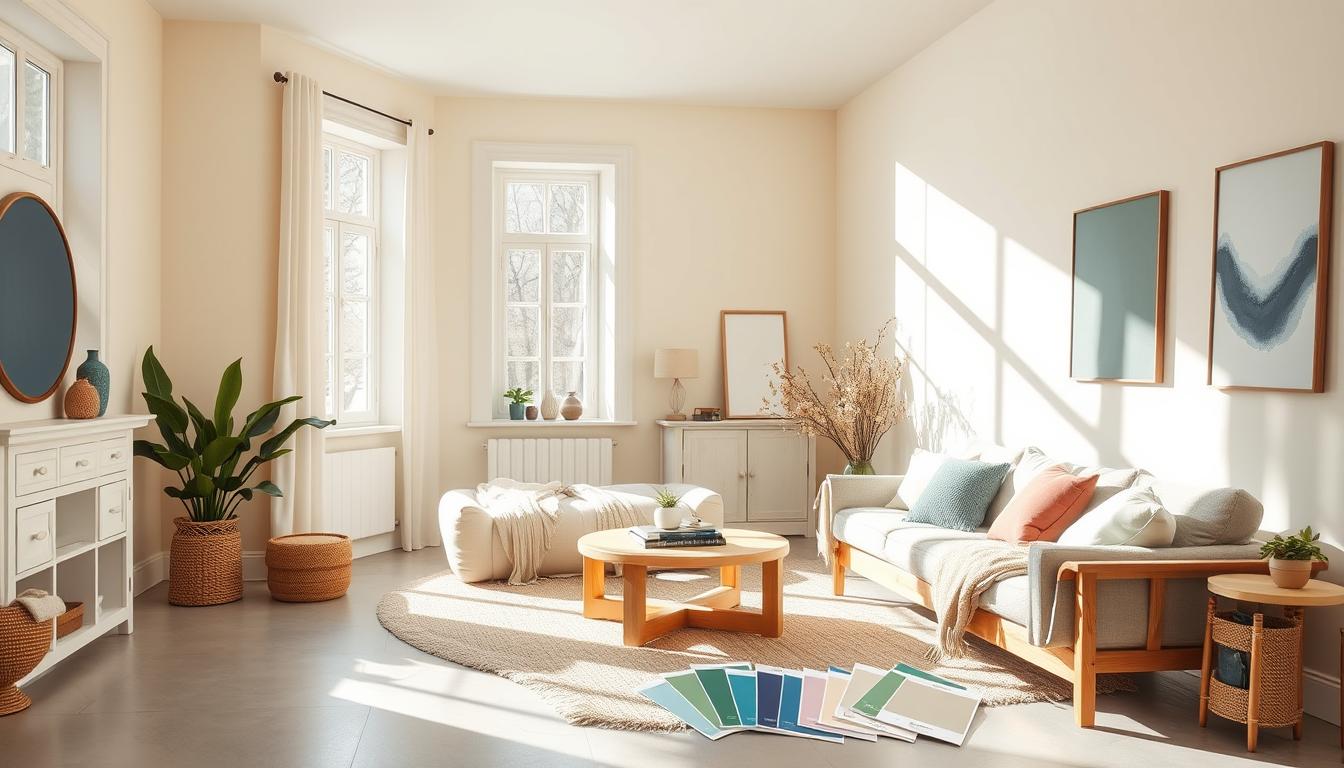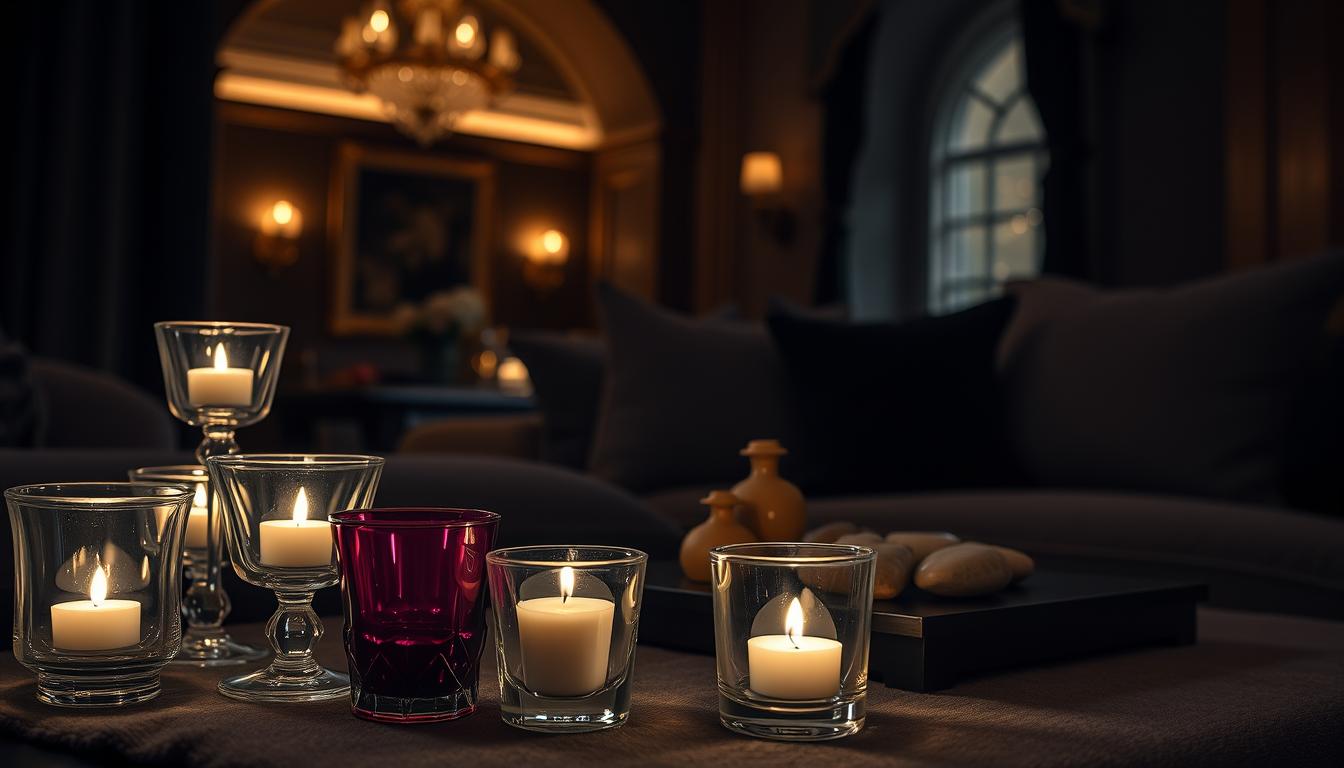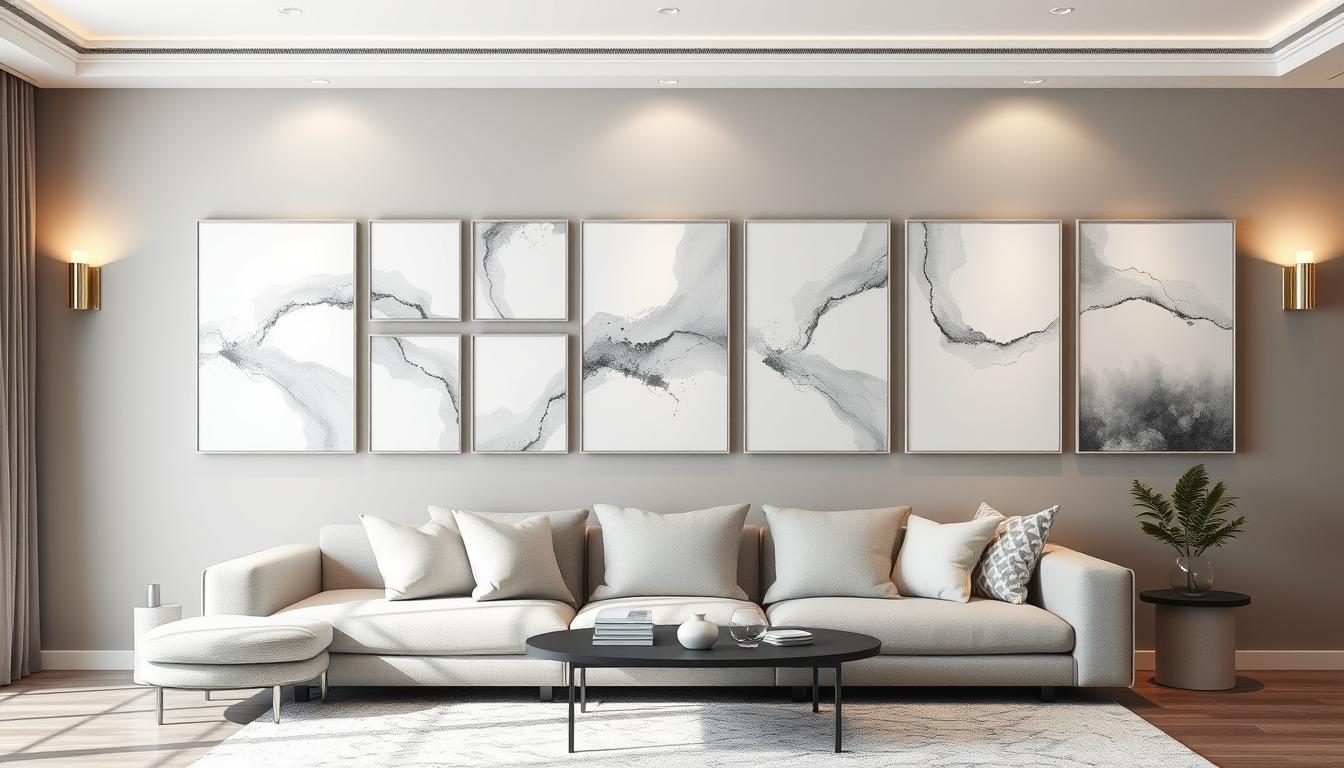Did you know that the colors in your home can affect your mood and how well you work? Selecting the right paint colors can be tough, but with the right help, you can make a space that looks great and works well.
At Interior Grove, we know how crucial it is to get the color palette right. That’s why we’re sharing our knowledge on painting your home’s interior and more. This way, you can make smart choices. By learning about color theory and checking your home’s lighting, you can pick the best paint colors for your home.
Key Takeaways
- Understand the basics of color theory to make informed decisions.
- Assess your home’s lighting conditions to choose the right colors.
- Explore popular color trends to inspire your choices.
- Consider the psychological impact of colors on mood and productivity.
- Get tips on how to apply these principles to your home’s interior.
Understanding Color Theory and Its Impact on Spaces
Color theory is the base of great interior design. It shapes the feel of your living areas. Learning its basics can really boost your home’s look.
The Color Wheel: Primary, Secondary, and Tertiary Colors
The color wheel is a key tool in color theory. It shows how colors connect. It starts with primary colors (red, blue, and yellow), which can’t be mixed from other colors.
Secondary colors (orange, green, and purple) come from mixing primary colors. Tertiary colors mix primary and secondary colors, like blue-green or red-orange. Knowing these color connections helps pick color schemes for interior painting that work well together.
Warm vs. Cool Colors: Setting the Mood
Colors are either warm or cool. Warm colors (reds, oranges, and yellows) bring energy and warmth. They’re great for lively areas like living rooms or dining rooms.
Cool colors (blues, greens, and purples) calm the space. They’re best for bedrooms or bathrooms where you want to relax. Choosing between warm and cool colors greatly affects a room’s mood and feel, guiding your interior design paint choices.
The Importance of Undertones
Undertones are the hidden colors in a color. They can be warm, cool, or neutral. They’re key in how colors look together and with your home’s lighting.
A paint with a warm undertone might look different under artificial light versus natural light. Knowing undertones helps pick paint colors that match well together and your home’s style.
Assessing Your Home’s Lighting Conditions
To pick the right paint colors, you need to check your home’s lighting. Lighting greatly affects how colors look on your walls. It’s a key factor in selecting paint for your house.
Natural vs. Artificial Light: How They Affect Color
Natural light makes colors pop, while artificial light can change their look. This is important for choosing the right paint colors for your home.
LED bulbs give off a cool, blue-ish light. Incandescent bulbs have a warmer, yellow-ish glow. Knowing this helps you pick the best paint colors.
The Role of Different Light Sources
Light sources in your home change how paint colors look. For example:
- Table lamps make colors richer with their warm light.
- Overhead lighting spreads light evenly, affecting color perception.
- Natural light from windows changes throughout the day, impacting color.
Timing: How Daylight Affects Perception
The time of day and your windows’ direction matter a lot. For instance:
- Morning light is cooler, making colors seem more muted.
- Afternoon light is warmer, making colors more vibrant.
Watching your space at different times helps you see how colors will look. This gives tips for choosing home paint colors that look good all day.
Thinking about these factors helps you choose paint colors wisely. This way, your colors will match your home’s lighting perfectly.
Considering Existing Elements in Your Home
A well-designed home starts with balancing paint colors with what you already have. It’s key to think about all parts of your home’s look when picking colors.
Fixed Features: Flooring, Trim, and Fixtures
Things like flooring, trim, and fixtures greatly affect your paint choices. For example, dark hardwood floors look better with lighter walls. This makes your room feel bigger.
The color of your trim and fixtures also matters. If your trim is white, you can pick almost any wall color. But if it’s another color, you need to match it.
Furniture and Decor: Enhancing or Clashing?
Don’t forget about your furniture and decor when picking paint. You want your walls to match your furniture, not clash. A bold sofa calls for neutral walls.
But if your furniture is simple, use your walls to add some flair. A bolder color can really make a statement.
Creating a Cohesive Look Throughout Spaces
Having a consistent look in your home is important. Choose a color scheme that ties everything together. You don’t need the same color everywhere, but similar shades work well.
Think about how colors move from room to room. This helps create a smooth flow and a welcoming atmosphere.
By picking paint that matches your home’s features, you can make a space that’s both beautiful and personal. It will feel like home.
Exploring Popular Color Trends for Interiors
Color is key in home interiors today. The right colors can make a house feel modern, cozy, or lively. We’ll look at current trends, including neutral colors, bold hues, and regional favorites in the U.S.
Neutral Palettes: Timeless Choices
Neutral colors like white, beige, and gray are always in style. They create a calm and clean look. These colors work well with many furniture styles, making it easy to decorate.
Want to know more about choosing the perfect colors for your home? Check out our guide on finding the ultimate color palette.
Bold and Vibrant Colors: Making a Statement
Bold colors like deep blues, emerald greens, and rich yellows add energy to rooms. They’re great for accent walls, furniture, or decor. Used right, they can draw attention and add depth.

Regional Trends: What’s Popular in the U.S.
Color trends vary by region in the U.S. Coastal areas often use light colors that match the sea. Urban spots might prefer bold, modern shades. Knowing these trends helps homeowners pick colors that fit their area.
| Region | Popular Colors | Influences |
|---|---|---|
| Coastal | Light blues, sandy neutrals | Natural surroundings, beach culture |
| Urban | Bold reds, deep grays | Modern architecture, city lifestyle |
| Rural | Earth tones, muted greens | Natural landscape, traditional styles |
By keeping up with interior design trends and understanding regional colors, homeowners can choose wisely. This enhances their living spaces.
Using Samples to Test Colors
Testing paint colors with samples before making a final decision is a smart move. It saves time and money. Homeowners can see how different shades look in their specific lighting and surroundings.
The Importance of Paint Swatches
Paint swatches are crucial in choosing colors. They give a more accurate color view than a small paint chip. By holding the swatch against different room elements, you can see how the color fits with your furniture and decor.
Using paint swatches effectively involves:
- Placing the swatch on different walls to see how the color looks in various lighting conditions.
- Observing the swatch at different times of day to understand how the color changes.
- Comparing the swatch to your furniture and decor to ensure the color complements them.
Painting Small Areas: A Smart Approach
Painting small areas, like a single wall or a section of a wall, is another smart way to test colors. This method lets you see the color’s interaction with the room’s lighting and other elements on a larger scale.
As noted by interior design experts, “Painting a small area can reveal nuances in the color that might not be apparent from a swatch.”
Observing Changes Over Time: Day and Night
Colors can look different under various lighting conditions. Watching your paint samples during the day and at night, under both natural and artificial light, helps you understand how the color will perform.
“The true test of a paint color is how it looks at different times of day,” says a renowned interior designer. “A color that looks perfect in the morning might not be as appealing at night under artificial lighting.”
“A color that looks great on a small swatch can completely change when applied to a larger area. Testing is key.”
Choosing Colors for Different Rooms
Different rooms in your home have their own roles. The colors you pick should match each room’s purpose. The best paint colors for your home change from room to room, based on what you want each space to feel like.
Living Spaces: Inviting and Comfortable Choices
Living rooms are where we relax, entertain, and spend time with others. So, the colors should be welcoming and cozy. Neutral shades like beige, soft grays, and creamy whites are favorites because they make the room feel warm and inviting.
But, adding a bold accent wall or using vibrant colors in furniture and decor can make the space more lively.
Bedrooms: Creating a Relaxing Oasis
Bedrooms are our personal retreats where we rest and recharge. The colors should help us relax and feel calm. Soft blues, pale greens, and muted purples are great for this.
It’s also important to think about the room’s natural light. How the colors look at different times of day matters a lot.
Kitchens and Dining Areas: Energizing Hues
Kitchens and dining areas are the heart of the home, where meals are made and memories are created. For these areas, bright and warm colors work well. Shades of red, orange, and yellow can make you hungry and encourage conversation.
But, it’s key to balance these bold colors with neutral ones. This prevents the space from feeling too much.
When picking colors for painting, think about each room’s role and how you want to feel there. Tailoring your color choices to each room’s needs helps create a home that’s both harmonious and functional.
Understanding the Psychology of Color
Colors have a big impact on our mood and well-being. Choosing the right paint colors for our homes is important. It can change how we feel and behave.
How Colors Affect Mood and Behavior
Colors can make us feel different ways. Warm colors like red and orange make us feel energetic. Cool colors like blue and green calm us down. Think about how colors will affect the people who live in your home.
For example, warm colors in a living room make it cozy. Cool colors in a bedroom help us sleep better.
Psychological Effects of Popular Shades
Some colors are popular for good reasons. Soft neutrals like beige calm us down. Deep blues and rich greens make us feel relaxed and connected to nature.
Bold colors like bright red add energy. But use them carefully to avoid overwhelming the space.
Color Choices for Specific Needs
Each room in our homes has its own purpose. A home office might need stimulating colors like orange. A meditation room should have calming colors like light blue.
Think about the room’s function and the mood you want to create. This way, you can use color to make your home better.
Understanding color psychology helps us choose the best paint colors. It makes our homes more comfortable and improves our well-being.
Seeking Inspiration from Various Sources
When looking for the perfect home color scheme, we often miss out on great sources of inspiration. The natural world and the digital space are full of ideas. They can spark creativity and help us make our choices.
Nature: A Great Guide for Color Palettes
Nature is a great source of inspiration for home colors. The sunset’s colors, a forest’s hues, and rocky landscapes’ shades are all useful. By watching nature, we can make color schemes that mirror its beauty.

Interior Design Magazines and Blogs
Interior design magazines and blogs are also full of ideas. They show the latest styles, from modern to vintage. They also give tips on picking colors. Following these trends helps make sure our colors are both trendy and stylish.
Social Media Platforms: Gathering Ideas
Social media like Instagram and Pinterest are key for finding home color palette ideas. People share their favorite color schemes, creating a huge pool of inspiration. By checking these platforms, we can find patterns and themes that match our style.
By using inspiration from these different places, homeowners can create a unique and beautiful color palette. This can really make their living space stand out.
Consulting Professionals When Needed
Getting professional help can make a big difference in choosing paint colors for your home. We can give you many tips and guidelines. But sometimes, it’s best to talk to experts who know how to help you choose the best colors for your home.
When to Hire an Interior Designer
If you’re doing a big renovation, buying a new home, or want a big change, consider hiring an interior designer. They can help you create a look that shows your style and fits your home’s design.
Working with Color Consultants
Color consultants know how colors work with light and surroundings. They can help you understand the latest trends and how to use them in your home. They also give advice based on what you like and your home’s features.
Benefits of Getting Expert Opinions
Getting expert opinions can save you time and money. Professionals can suggest creative ideas you might not think of. They can also help you pick from the many paint options out there. Plus, their fresh view can help you make choices you’ll love for years.
Using the help of interior designers and color consultants ensures your home looks great. Whether you want to update one room or your whole house, getting professional advice is a smart choice.
The Importance of Personal Preference
Your personal taste is key in picking the right paint colors for your home. Trends and expert tips can help, but the colors should show who you are and make you feel at home.
Reflecting Your Style: What Colors Speak to You?
Think about what you love and the vibe you want in your home. Look at your favorite art, furniture, or even your clothes. These can inspire your color choices.
For instance, warm wood furniture calls for earthy shades. Vibrant artwork demands bold colors to stand out.
Balancing Personal and Trendy Choices
It’s important to show your style, but trends can also be interesting. Mix trendy colors in small ways, like accent walls, and timeless colors in bigger areas.
A practical approach is to use trendy colors in living rooms, which change more often. Stick to classic colors in bedrooms, where changes are less common.
Creating a Unique, Personalized Space
Don’t be shy to try new color mixes. Get ideas from nature, art, or places you love.
- Think about the mood you want in each room.
- Consider how light changes the color.
- Test colors with samples before making a final choice.
By following these steps, your home will not only look amazing but also truly reflect you.
Finalizing Your Color Palette
We’ve looked at many ways to pick paint colors. Now, it’s time to pick the right colors for your home. This means choosing colors that work well together and feel right to you.
Simplifying Your Options
Start by picking fewer colors. We talked about testing colors with samples. Use this to pick a few colors that look good together and match your style.
Creating Continuity
Think about how your colors will connect your home’s rooms. Pick a main color or theme that ties everything together. This makes your home feel smooth and connected.
Making the Final Decision
Trust your gut when deciding. Think about how you want to feel in your home. Choose colors that make you feel good. This way, you’ll pick the best colors for your home and create a beautiful space that shows your style.



